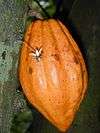Theobroma bicolor
| Theobroma bicolor | |
|---|---|
_1.jpg) | |
| Scientific classification | |
| Kingdom: | Plantae |
| (unranked): | Angiosperms |
| (unranked): | Eudicots |
| (unranked): | Rosids |
| Order: | Malvales |
| Family: | Malvaceae |
| Genus: | Theobroma |
| Species: | T. bicolor |
| Binomial name | |
| Theobroma bicolor Humb. & Bonpl. | |
| Synonyms | |
|
Theobroma ovatifolia Moc & Sessé ex DC. | |
Theobroma bicolor, known commonly as the Mocambo tree, jaguar tree, balamte,[1] or pataxte, among various other common names, is a tree in the genus Theobroma (family Malvaceae), which also contains the better-known Theobroma cacao (cocoa tree). It is known from Central and South America, including stretches of the Amazon rainforest in Brazil, Colombia, Ecuador, and Peru.
Taxonomy
T. bicolor is the only species in the Rhytidocarpus section of Theobroma.[2] It was described by Alexander von Humboldt and Aimé Bonpland in 1808.[3]
Description
T. bicolor can reach a height of 3–8 metres in open fields, although in the understories of forests it can grow to 25–30 metres.[2] It is a slow-growing tree and grows best in loose, unconsolidated soils. It is adapted to survive flooding at a minimal level, but can sometimes last in deeper floods.[4] In the central Amazon region, the tree produces fruit from March to November, and flowers from July to September.[2]
It's fruit is the same family of cocoa. Its seeds are edible, give a lot of energy, are rich in protein and fiber. Also are high in Omega 9 and Theobromine, an alkaloid with stimulant effects, giving you well being, similar to cocoa and coffee, but more subtle. Their properties benefit our brain, giving us more alertness and attention. It's a healthy snack, and can be eaten with chocolate cover at 74% or 75% for a sweet taste.
Other given names: Perú: Macambo, Majambo or Cerebrito (“little brain”) Brasil: Cacau do Perú Colombia: Bacau English: Patashte
Nutritional facts Components 100 g pulp Energy 44,0 cal Water 88,0 g Protein 2,1 g Lipids 0,8 g Carbohydrates 8,3 g Fiber 0,7 g Ceniza 0,8 g Phosphor 44,0 mg Iron 0,5 mg Vitamin A (Retinol) 28,0 mg thiamine 0,08 mg Riboflavin 0,09 mg niacin 3,10 mg Ascorbic acid 22,80 mg
Cultivation and Use

T. bicolor was historically cultivated by the Aztecs alongside T. cacao for production of chocolate, although when chocolate was introduced to the Spaniards, they considered the product of T. bicolor to be of a lower quality.[5] Its seeds can also be eaten fried or in soups, and the seed pods when emptied are used as planters and containers.[4] The pulp which surrounds the seeds can be eaten fresh, and has a sweet, mild taste.[2]
When the fruit is ripe, it naturally detaches from the tree branches and falls to the ground; the general method of harvesting is collecting the fallen fruit.[2]
Mayas placed a high value on the buttery foam crowning beverages of cacao and maize, according to descriptions from the time of the Conquista, and it appears that a thick, stable foam can be produced using fruits of T. bicolor as source of cacao, but not with T. cacao fruits.[6]
Pests
Moniliophthora perniciosa, a fungus which causes "witch's broom disease" on T. cacao, was reported on a Brazilian specimen of T. bicolor in 1999.[7]
References
- ↑ The Jaguar Tree (Theobroma bicolor Bonpl.) by Johanna Kufer and Cameron L. Mcneil. Published by the University Press of Florida.
- 1 2 3 4 5 Page 289, Food and Fruit-Bearing Forest Species, 3: Examples from Latin America/F2911 Food and Agriculture Organization of the United Nations. Forest Resources Development Branch, 1986. ISBN 9251023727/ISBN 9789251023723
- ↑ Page 1578, Mansfeld's Encyclopedia of Agricultural and Horticultural Crops: (Except Ornamentals), by Peter Hanelt, Institute of Plant Genetics and Crop Plant Research; and R. Kilian, W. Kilian. Springer, 2001. ISBN 3540410171/ISBN 9783540410171
- 1 2 Theobroma bicolor (Macambo) at www.rainforestconservation.org.
- ↑ Pataxte and cacao in Mayan ethnobotany, iconography, and art history by Nicholas M. Hellmuth, at www.maya-archaeology.org.
- ↑ Judith Strupp Green. 2010. Feasting with Foam: Ceremonial Drinks of Cacao, Maize, and Pataxte Cacao. Pre-Columbian Foodways 2010, pp 315-343.
- ↑ Theobroma bicolor host of Crinipellis perniciosa in Southern Bahia. Lopes, J. R. M.; Bezerra, J. L.; Luz, E. D. M. N. Agrotrópica, 1999 Vol. 11 No. 2 pp. 97-100. ISSN 0103-3816
8. http://www.deperu.com/abc/frutas/5262/el-macambo 9. @ESholisticnutrition
External links
| Wikispecies has information related to: Theobroma bicolor |
- Theobroma bicolor at ITIS
- Theobroma bicolor at www.rarepalmseeds.com.

